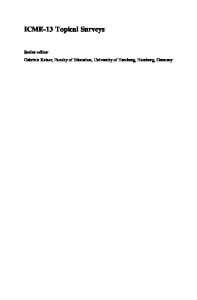(Mathematics) Curriculum, Teaching and Learning
As mathematics curricula around the world have undergone significant reform in recent years, it is time to re-think the role of the curriculum for mathematics learning and teaching. What shape would such a curriculum have (the final product) if it does un
- PDF / 279,213 Bytes
- 14 Pages / 441 x 666 pts Page_size
- 51 Downloads / 435 Views
Abstract As mathematics curricula around the world have undergone significant reform in recent years, it is time to re-think the role of the curriculum for mathematics learning and teaching. What shape would such a curriculum have (the final product) if it does undergo this kind of reform? Who are the ‘end-users’ of the curriculum and what are the inter-relationships among the curriculum, the teachers, and the students? This chapter attempts to summarize and comment on the various chapters in this book and to initiate further reflection and discussion on these issues. Keywords Mathematics curriculum · Mathematics teaching · Mathematics curriculum reform
Prologue Mathematics curricula around the world have been undergoing reform for more than a decade, so it is now time to re-think the role of the curriculum in the learning and teaching of mathematics. The chapters in this book contribute to our understanding of the role and purpose of a mathematics curriculum, as well as of mathematics teaching and learning in the context of reform in the various educational regions.1 Rather than setting out a firm position on various issues, the authors have chosen to raise a number of questions on various related aspects, in the hope that these questions would act as fuel to drive further reflection and professional discourse.
1 The term ‘region’ is used throughout this chapter for consistency. Some regions (e.g., Japan) are countries, while others (e.g., Hong Kong) are not.
The word ‘mathematics’ is in parentheses since we believe that many of the issues in this chapter are not confined to mathematics. N.-Y. Wong (B) · Q. Zhang Department of Curriculum and Instruction, The Chinese University of Hong Kong, New Territories, Hong Kong e-mail: [email protected] X. Li Department of Psychology, Shenzhen University, Shenzhen, China Y. Li, G. Lappan (eds.), Mathematics Curriculum in School Education, Advances in Mathematics Education, DOI 10.1007/978-94-007-7560-2_28, © Springer Science+Business Media Dordrecht 2014
607
608
N.-Y. Wong et al.
Standardization in the Current Reform of the Mathematics Curriculum In the West, prior to the modern mathematics movement of the 1960s, there had been virtually no change in the mathematics curriculum and textbooks for a very long time. There was little difference between the pre-second-world-war and postsecond-world-war traditional textbooks because both were based on what has since been called the pre-1800 model (Cooper 1985). Following the modern mathematics movement, there were widespread reforms of the mathematics curriculum around the world at the turn of the millennium (Wong et al. 2004). Among other factors, these changes were triggered by several large-scale international comparisons, such as the Second IEA Mathematics Study (SIMS), the 1992 International Assessment of Education Progress (IAEP) mathematics study, and the Third International Mathematics and Science Study (TIMSS).2 Though Hirabayashi did state that “having a high achievement in international mathematics studies is no
Data Loading...











